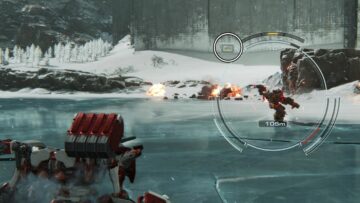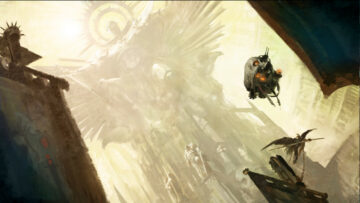The 2020 Demon Slayer movie made headlines and history when it premiered in Japan in late October. The first feature-length film based on the popular Shonen Jump manga and anime series amassed more than $350 million at Japan’s box office during its opening weekend, surpassing not only the record set by Hayao Miyazaki’s Spirited Away as the highest grossing Japanese film of all time, but the fourth-highest grossing film of 2020, period. This happening as the future of the film industry remains in flux in the wake of the COVID-19 pandemic speaks to the evident fact of anime’s economic and cultural dominance as global entertainment.
Now, more than half a year since the film’s release, Demon Slayer: Kimetsu no Yaiba the Movie: Mugen Train finally makes landfall in the States. Given the massive concentration of fanfare and newfound mainstream attention toward the series in the wake of its premiere, the question remains: Is this film worthy of the hype? For the most part, it emphatically is.

Directed by Haruo Sotozaki, who oversaw Demon Slayer: Kimetsu no Yaiba’s first season and is set to return for season 2 next year, Mugen Train picks up immediately after the events of the end of the first season. Series protagonist Tanjiro Kamado, his demon-slayer cohorts Zenitsu and Inosuke, and his demon-possessed but pacified sister Nezuko race to assist the upper-rank demon-slayer Kyojuro Rengoku, also known as the Flame Hashira, in investigating the disappearance of 40 people aboard the mysterious Mugen Train. (Mugen is Japanese for “Infinite,” but this has nothing to do with Infinity Train.)
More than simply a continuation of the series’ broad plot, the film is based directly on an arc of Koyoharu Gotouge’s original manga, and is intended as a canonical bridge between the events of season 1 and 2. This itself is novel: Most popular anime franchises (e.g. My Hero Academia, Naruto, Dragon Ball, etc.) boast one or more feature-length movies, which tend to be fun, non-canonical side stories, unconcerned with the arc of the series’ main characters and more focused on “what-if” scenarios. Usually, anime franchise films allow for more loose experimentation in terms of animation and characterization.
For the most part, Mugen Train benefits from its role as a canonical footnote in the series’ larger arc, with one exception. Curious newcomers to the series will be left adrift, given the absence of exposition around the characters or who they’re fighting and why. There’s no straight answer about exactly what a “Flame Hashira” is, or a clear explanation of Enmu, Mugen Train’s antagonist. The movie doesn’t explore what that freaky “Lower Rank 1” kanji tattoo on their eye means, other than the obvious implication that (1) they’re a demon, and (2) they’re out to slay demon slayers.

Mugen Train assumes the audience knows what was covered in season 1. There’s no time for a recap, as the film uses every minute of its two-hour runtime in service of pushing the plot forward. That might sound like a knock against the film, but truthfully, the ideas and themes at the core of Demon Slayer: Kimetsu No Yaiba’s appeal remain intact, to the point where, even without exposition, the film is bound to be a blast not just for existing fans, but for anyone tapping in to see some whiz-bang swordplay and extravagant 3D action scenes. There are plenty of both here.
With most of the main creatives on the television series returning for the film, the break between the art style and visual composition of the film and the anime series isn’t dramatic. The dynamic CG-animated set pieces which characterized several of the most visually remarkable sequences in the first season return in Mugen Train. Some of the impeccably rendered fight scenes and dramatic beats rival or even eclipse the anime’s most notable moments, like the Inception-esque rotating climax of the Tsuzumi Mansion Arc, or the breathtaking finale of the first season’s phenomenal 19th episode, “Hinokami.”
While Mugen Train doesn’t address how the characters ended up in this story, the writers do a fantastic job of communicating why viewers should care about them, particularly in the case of Kyojuro Rengoku. Introduced late in the first season, Kyojuro wasn’t given much personality or motivation. Mugen Train addresses the problem by revealing that in spite of Rengoku’s imposing reputation as one of the elite members of the Demon Slayers Corps, and his phenomenal, nigh-otherworldly prowess as a swordsman, he’s truthfully just a big, unblinking dork with a not-so-subtle ego, a burning desire to aid others, and a moderately tragic backstory concerning his father’s legacy as the previous Flame Hashira. In a movie packed with exciting and memorable scenes, Rengoku is the center of most of them. He’s likely to become the film’s breakout character, especially after he takes center stage during Mugen Train’s explosive finale. The dramatic outcome of that sequence will undoubtedly reverberate throughout the series’ future moving forward.

Ultimately, what makes Demon Slayer: Kimetsu no Yaiba the Movie: Mugen Train a great film, aside from being a pitch-perfect adaptation and interstitial continuation of the anime series, is that it homes in on what makes its core cast of characters tick, and encapsulates that appeal in memorable standout scenes. Early on in the film, Tanjiro and his cohorts are ensnared by Enmu, who uses a spell to make their deepest desires manifest. For Rengoku, that dream amounts to being adored and sharing a moment of sibling bonding with his younger brother Senjuro. For Tanjiro, it’s for his sister Nezuko to be restored to her human self and reunited with his family, who were slaughtered by the series’ principal antagonist. And for Zenitsu, it’s an idyllic moment of comic, romantic bliss with Tanjiro’s sister.
But the most memorable of the dream sequences is Inosuke’s: It portrays him as some sort of militant mole-man spelunking through a subterranean cavern, along with anthropomorphic animal caricatures of Tanjiro, Zenitsu, and Nezuko. It gets weird. The film returns to these dream worlds periodically throughout the film, ingratiating the audience with Tanjiro and his cohorts via the moments and people that matter most to them, intermingled with their own respective quirks and eccentricities. It’s enough to literally pull the audience into the headspace of Demon Slayer: Kimetsu no Yaiba’s protagonists and drive home just why exactly the series has endeared itself to so many fans of both the manga and anime series.
Demon Slayer: Kimetsu no Yaiba the Movie: Mugen Train is a brilliant encapsulation of the series’ strengths and appeal, filled with moments of pulse-pounding action, heady emotional gravitas, and fantastic character-affirming moments of levity and humor. It isn’t the best point for series newcomers to hop aboard the Demon Slayer: Kimetsu no Yaiba fandom, but nonetheless, it affirms itself as a thoroughly entertaining thrill-ride that feels both consequential and essential to watch.
Demon Slayer: Kimetsu no Yaiba the Movie: Mugen Train will release in theaters on April 23. Before visiting a movie theater, Polygon recommends reading our guide to local state-by-state COVID precautionary measures.
Source: https://www.polygon.com/22388386/demon-slayer-movie-mugen-train-review
- 3d
- Action
- animation
- Anime
- appeal
- April
- around
- Art
- audience
- BEST
- Box
- box office
- breakout
- breathing
- BRIDGE
- care
- charges
- concentration
- Covid
- COVID-19
- COVID-19 pandemic
- Early
- Economic
- Entertainment
- etc
- events
- eye
- family
- Film
- films
- First
- Forward
- Franchise
- fun
- future
- Global
- great
- head
- Headlines
- here
- history
- Home
- How
- HTTPS
- Humor
- industry
- IT
- Japan
- Job
- jump
- local
- Mainstream
- mansion
- Members
- million
- Most Popular
- movie
- Movies
- Other
- Others
- pandemic
- People
- Personality
- Plenty
- Popular
- Premiere
- protagonist
- Race
- recap
- returns
- Rival
- Series
- set
- So
- Stage
- States
- Stories
- television
- The Future
- Theater
- time
- Watch
- Water
- weekend
- WHO
- year










